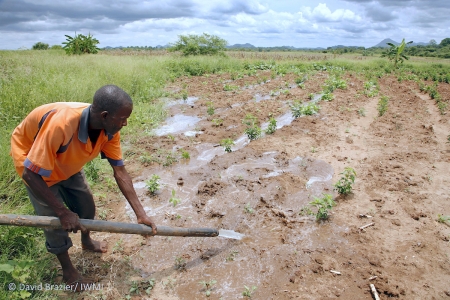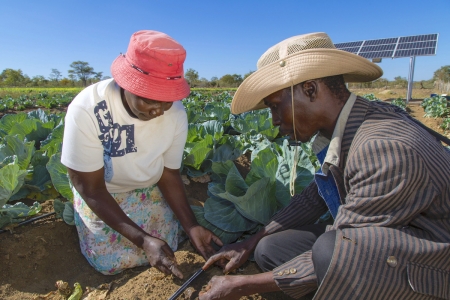An evaluation of CGIAR's work on 'solar power as a remunerative crop' finds that it has contributed to the adoption of a more inclusive and sustainable approach in major Indian government programs
The dark side of the sun
Solar-powered irrigation could be touted as a modern-day exemplar of hi-tech India, nestled within the larger narrative of the irrigation that propelled the Green Revolution. With groundwater now supplying 60% of irrigation across the country, the emergence of solar pumps is allowing farmers to draw water without using energy derived from coal-powered plants or diesel-powered pumps. However, there is a dark side to 'sunshine farming'. Once installed, solar power is free – and this can exacerbate the ongoing depletion of scarce water resources, particularly in the drier north-western and peninsular regions of India.
How, then, to avoid unintended consequences while continuing to incentivize solar irrigation as part of a sustainable agricultural model? The idea of Solar Power as a Remunerative Crop (SPaRC), wherein farmers are encouraged to sell surplus solar power to the grid rather than over-pump groundwater, was developed as one such solution. The International Water Management Institute (IWMI), as part of its IWMI-Tata Water Policy Research Program (ITP), has been working on SPaRC since 2012, with support from the CGIAR Research Programs on Water, Land and Ecosystems (WLE) and Climate Change, Agriculture and Food Security (CCAFS).
A recent independent evaluation has considered the contribution of Tata Trusts, WLE and CCAFS to the uptake of SPaRC in Indian government programs, in particular Gujarat's Suryashakti Kisan Yojana (SKY) and the Pradhan Mantri Kisan Urja Suraksha edam Utthan Mahabhiyan (PM-KUSUM), for which the Government of India has allocated US$4.5 billion up to 2022.
A key role in scaling solar power sustainably and equitably
In a typical off-grid solar irrigation pump, all the energy generated by solar panels is either used for pumping water or is wasted. This results in a perverse incentive to pump as much as possible, often leading to wasteful and unsustainable pumping behavior. Under SPaRC, farmers are in a position to irrigate their fields with solar irrigation pumps, and are also offered a feed-in-tariff to sell any surplus solar power to the grid. This creates an incentive for farmers to use energy (and water) judiciously. Well-publicized success stories from the field demonstrate that an average farmer can earn US$870 additional income a year, over half of the average annual farm income of US$1,440. This can also insure against crop failure and contribute to improved climate resilience. In turning farmers from consumers of subsidized farm power to net producers of green energy, SPaRC can also significantly reduce India's farm power subsidy burden – currently exceeding US$15 billion per year – and reduce greenhouse gas emissions. All these will feed into Prime Minister Modi's recent pledge at COP26 to ramp up non-fossil fuel energy production (mostly solar) to 450 gigawatts by 2030.
The evaluation found that ITP played a key role in getting SPaRC to be recognized as workable even before the pilots were completed, and thereafter adopted as one of three components in PM-KUSUM. Along with WLE, CCAFS and Tata Trusts, the Swiss Agency for Development and Cooperation (SDC) and Deutsche Gesellschaft für Internationale Zusammenarbeit (GIZ) also made important contributions.
The evaluation found that by framing research findings into practical policy recommendations, ITP was successful in influencing solar irrigation policy – the crucial first step in achieving scale. This was by no means coincidental. ITP's strategy is to prioritize 'problem-solving' research and explicitly target policy change through staff with strong management backgrounds who are comfortable engaging with policymakers.
An ecosystem of competition
Solar power is a brilliant idea – but adapting it to farmers' needs at scale in a way that is both sustainable and inclusive is not as simple as flicking a switch. The push to 'solarize' India has in fact created an ecosystem of competing models to achieve national targets. PM-KUSUM is a massive program, but consists of three models: KUSUM-A (setting up grid-connected solar or other renewable energy power plants), KUSUM-B (supporting farmers to install solar pumps in off-grid areas) and KUSUM-C (supporting small and marginal farmers in solarizing their grid-connected pumps).
IWMI's SPaRC model is most closely emulated in KUSUM-C, which envisages grid-connecting 1.5 million solar pumps by 2022. Effectively realizing this target would require active engagement with farmers and farmer institutions. This added complexity of KUSUM-C might lead policymakers, solar developers and even electricity utilities to prefer KUSUM-A or KUSUM-B, which require significantly less farmer engagement. However, it is hoped that community-based organizations can assist in this process. In 2020, the World Bank and the Ministry of New and Renewable Energy discussed supporting PM-KUSUM, in the context of the Reserve Bank of India's emphasis on revising lending guidelines to favor sustainable lending policies with a focus on lending to cooperatives.
Research into action in India and beyond
ITP's strength lies in translating research into policy action, and there is a lot that CGIAR itself can learn from its example as it reorganizes to become One CGIAR. The evaluation recommends that ITP continue to drive SPaRC forward, building coalitions of stakeholders who believe that the model can generate multiple benefits along the agriculture-water-energy nexus.
IWMI is doing this through the GIZ-supported 'Solar irrigation expansion in India' project, aimed at facilitating better decision making in the scaling and mainstreaming of solar irrigation in India, and the SDC-supported 'Solar irrigation for agricultural resilience' (SoLAR) project, which aims to sustainably manage water, energy and climate linkages through the promotion of solar irrigation pumps in Bangladesh, India, Nepal and Pakistan. IWMI is also actively engaged in sustainable groundwater development for smallholders in Africa – it is tapping synergies for South-South learning in the field of sustainable and inclusive solar irrigation expansion.
---
Thrive blog is a space for independent thought and aims to stimulate discussion among sustainable agriculture researchers and the public. Blogs are facilitated by the CGIAR Research Program on Water, Land and Ecosystems (WLE) but reflect the opinions and information of the authors only and not necessarily those of WLE and its donors or partners.
WLE and partners are supported by CGIAR Trust Fund Contributors, including: ACIAR, DGIS, FCDO, SDC, Sida and others.













